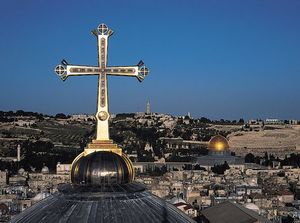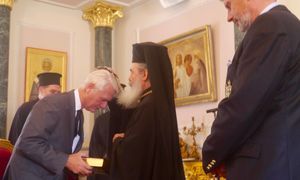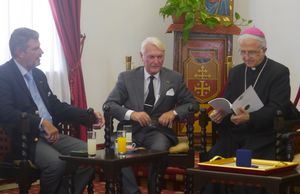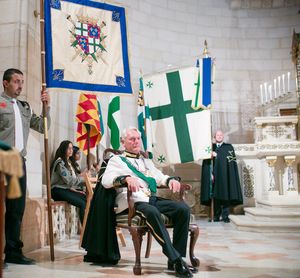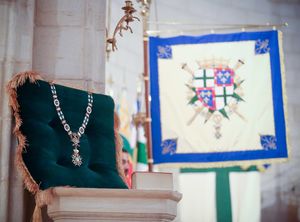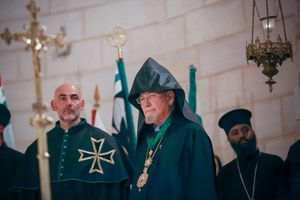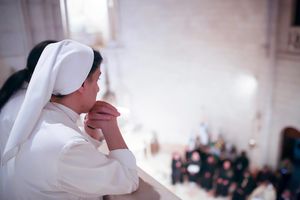Installation in Jerusalem
In mediaeval times, the first eleven Masters of the hospitaller knights who wear the green cross of Saint Lazarus inaugurated their leadership of the whole Order in Jerusalem.
Read more on our facebook page
The newly elected 50th Grand Master has now revived this tradition by being ceremonially installed, like his forebears, in Jerusalem, restored in this century as the magistral seat of the Order. As witnesses to this historic event, knights, dames and guests from many countries crossed the Mediterranean on pilgrimage to the Holy Land with their prince once again.
The first ‘Master of the Hospital of Jerusalem’, from 1099 to 1120, was Blessed Gerard, who is regarded as the founder of the various orders of hospitaller knights still in existence. On his feast day, 13 October 2015, his latest successor as Grand Master of the Military and Hospitaller Order of Saint Lazarus of Jerusalem, Prince Sixte-Henry de Bourbon-Parme, was personally invited to both the Latin and Greek patriarchates to pray and receive the patriarchal blessing upon himself and his insignia of office at the inauguration of his mission. This exceptional privilege was due to the fact that the Order of Saint Lazarus of Jerusalem is unique in admitting to its ranks, as equal members, Christians of both the Eastern (Orthodox) and Western (Catholic and Protestant) faith traditions, “the two lungs of the Church”.
The main group of pilgrims assembled in the Dormition Abbey outside the old city walls on Mount Sion for Mass in German with the Benedictine community, and then all descended to the abbey’s circular crypt that is centred on an evocative statue of the Virgin Mother of God in her final repose. Here the abbot led the candlelit night prayer vigil which is the traditional spiritual preparation for those who are being admitted to or taking on new responsibilities in the Order of Saint Lazarus. Among the participants were twenty candidates for investiture, from Serbia, France, Great Britain, Sweden and the Holy Land, who were due to be received by the Grand Master the next day. The celebrated Serbian soprano Gabrijela Ubavić adorned the service with traditional Orthodox chant and a rendition of Schubert’s ‘Ave Maria’.
In contrast to the reflective prayer vigil, the installation and investiture next day was a service that was both solemn and jubilant. It was held in the large church nearest to the site of the original Lazarite community, where Armenian monks first gave hospitality to leper knights over nine centuries ago. The church belongs to the Daughters of Charity and is dedicated to their founder, Saint Vincent de Paul, a priest who developed his charitable activities in the seventeenth century on the site of another Lazarite community in the district of Paris which still bears the name of Saint Lazare. It is good that the knights and the sisters who are their spiritual descendants continue in charitable works to benefit the poor and the sick in our times and their future collaboration is assured.
After readings from the scriptures, the appropriate formal testimonies were delivered and HRH Prince Sixte-Henry de Bourbon-Parme was then ceremonially installed as the fiftieth Grand Master under the ancient title of humilis magister domus Sancti Lazari in Ierusalem. The 200 members and guests present for the liturgy formed an astonishing ecumenical array, including Catholic and Orthodox bishops and priests of the Armenian, Melkite, Coptic, Russian, Ethiopian, Roman and several Protestant Churches, led by the president of Tantur Ecumenical Institute, with a Dominican of the École Biblique to preach the gospel. Besides diplomats from various countries, there were also a number of Muslim and Jewish friends of the Order in the congregation. The participation of local Christian scouts and a fine Polish choir to accompany the service was greatly appreciated.
During their pilgrimage, the Grand Master and members of the Order visited a number of the holy places and museums in Jerusalem and also took every opportunity to show their support for ‘the living stones’, the diverse Christian community of the land who continue to face many difficulties. Inspiring testimonies were given by the Mayor of Bethlehem, by the Russian Orthodox Sisters who run a girls’ school in Bethany, and by the monks of Mar Saba, whose simple desert community has had profound influence on the Eastern Orthodox and Byzantine Catholic Church since the fifth century. A particularly warm reception was given by parishioners in Beit Jala, where the Grand Master venerated the shrine of St Nicholas (who lived there for several years and on whose feast day this article is published in tribute).
Although the pilgrims were at all times safe and well treated, there were frequent signs of the Holy Land’s tensions. Prayers for peace and justice, especially at the time when the world recalls events there two thousand years ago, are a contribution that all can make towards a better future for those who live today in the place that is holy to all who believe in one God.
It is clear that in the Holy Land, historically stained in the Lord’s name by the blood of knights of Saint Lazarus as well as by so many others, the green cross of the Order of Saint Lazarus of Jerusalem is nowadays respected rather more for its ongoing commitment to charitable works across religious boundaries than in some other places, where orders of chivalry are regarded as an anachronism.
Prince Sixte-Henry therefore appeals to those who believe in the traditional noble values of Christianity to turn away from selfish motivations and promote instead the healing of body, mind and spirit of those in need. Conscious that disputes between knights have contributed to the disharmony, he invites all who follow the emblem of the green cross to strive for unity in faith and good works, collaborating for the benefit of our Mother Church of Jerusalem.
